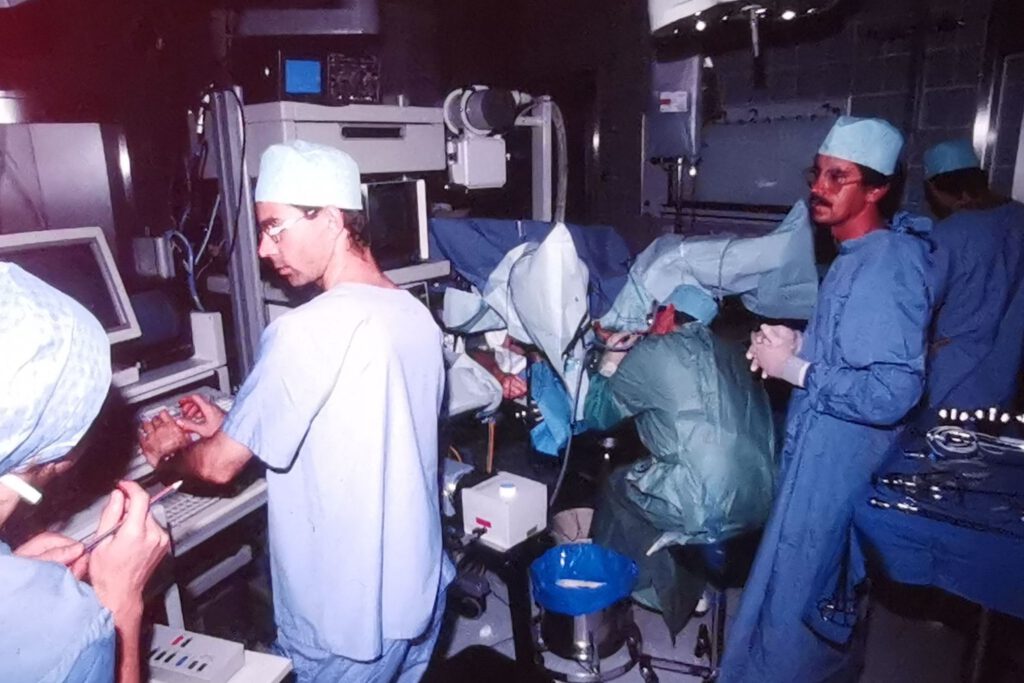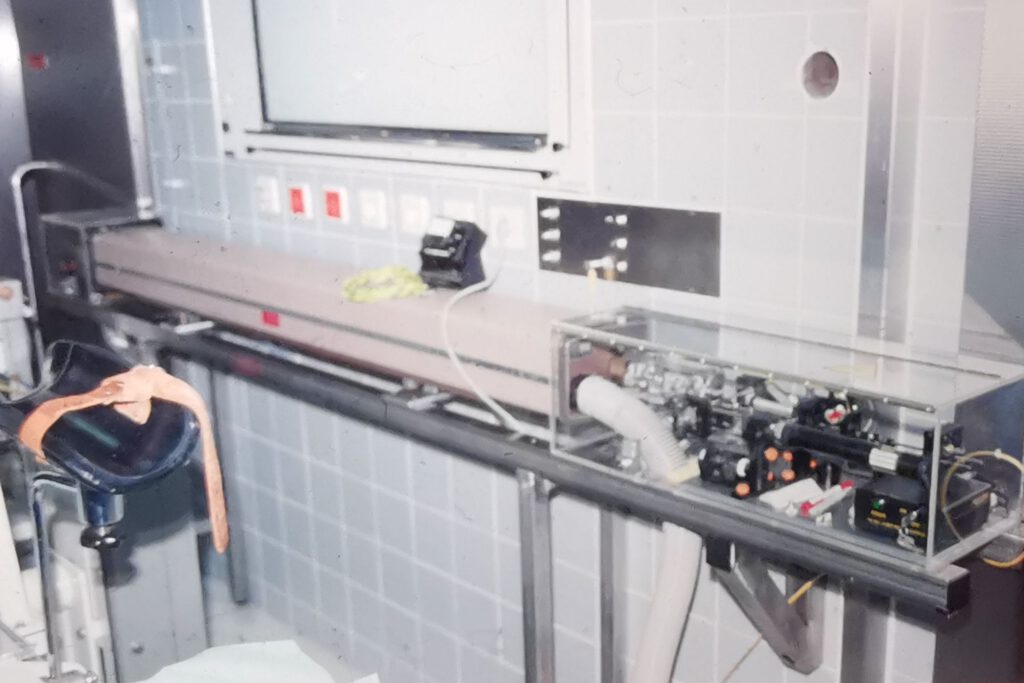How it started
The beginnings of laser application in medicine in Germany are closely associated with Munich urology. At the end of the 1960s, H. Müßiggang, then from the beginning of the 1970s together with A. Hofstetter, evaluated the possible applications of laser technology in surgery, but especially in urology. At that time, there was hardly any experience with the interaction of laser radiation and tissue. The industry mainly offered CO2, argon and neodymium:YAG laser systems. The CO2 laser with its unwieldy mirror joint arm for transmitting the laser radiation was not useful for endoscopic work. After G. Naht had developed suitable flexible glass fibers for the power transmission of argon and Nd:YAG lasers (1970), new possibilities opened up for these systems for endoscopic application in urology (endoscopy).
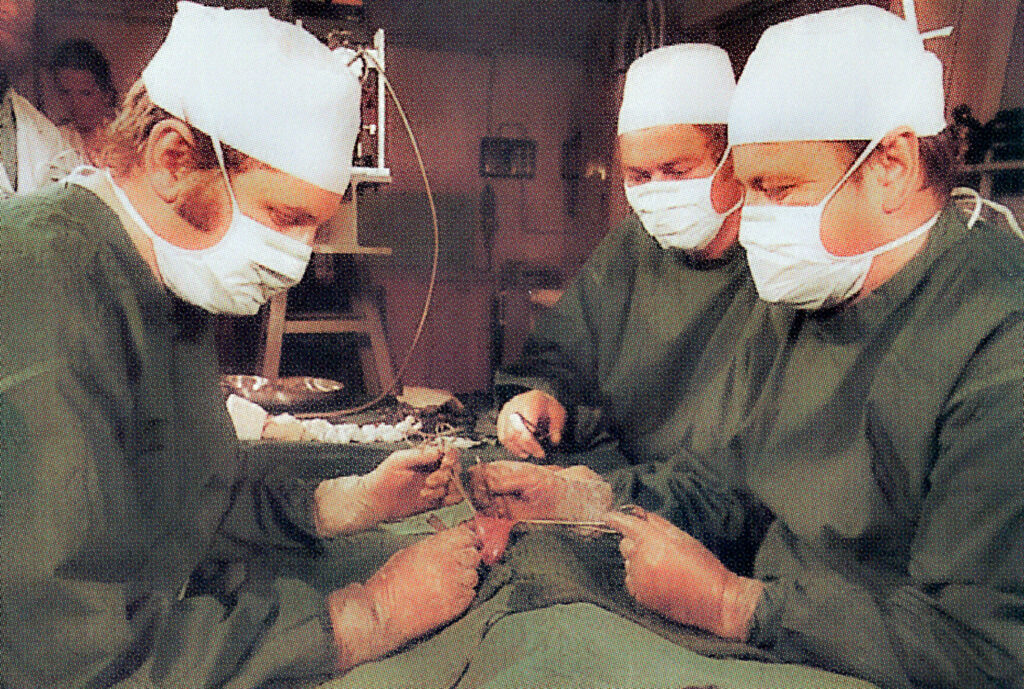
Experiment in the Neuherberg laser laboratory (ca. 1974)
The Federal Ministry of Research and Technology (BMFT) supported this new technology for medicine from 1972 onwards with the project planning of a so-called Central Laser Laboratory, funded from special BMFT funds and by the Volkswagen Foundation, under the project sponsorship of the Society for Radiation and Environmental Research (GSF) in Munich Neuherberg. The laser research started by W. Waidelich in 1963 at the Institute of Physics of the Technical University of Darmstadt and continued from 1976 at the Institute of Medical Optics of the Technical University of Munich, among others for medical applications, could be decisively strengthened by founding a department for coherent optics, later Institute of Applied Optics at the GSF. In connection with the Central Laser Laboratory, a first facility for targeted research in medical laser applications was created.
In addition, favored by the high-tech and innovative industry located in the Munich area and its generous support, ideal conditions existed in Munich for interested physicians to familiarize themselves with the technical and biophysical fundamentals of laser systems and the resulting clinical applications in theory and experiment.
In 1973 and 1974, the various working groups were established:
- Urology (A. Hofstetter G. Staehler, E. Keiditsch, F. Frank, Th. Halldorson),
- Gastroenterology (P. Kiefhaber, K. Moritz, G. Nath),
- Ophthalmology (R. Birngruber, W. Gorisch, R. McCord, W. Weinberg),
- Neurosurgery (F. Leheta, O. Beck),
- Gynecology (A. Götz, W. Albrich, W. Waidelich) und
- Dermatology (W. Waidelich, D. Haina, M. Landthaler),
In a concerted action, based on an initiative of A. Hofstetter, these groups joined together in 1976 to form a working group with the aim of joint promotion and interdisciplinary exchange of experience.
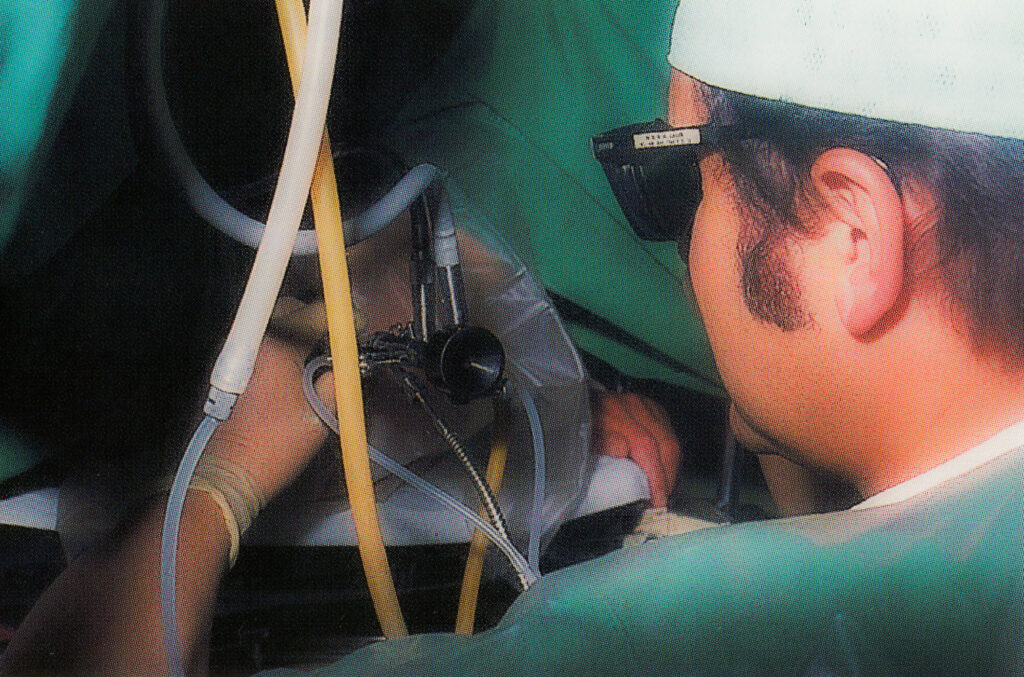
First endoscopic tumor destruction with a neodymium YAG laser (June 1, 1976, Alfons Hofstetter)
Subsequently, clinical application centers were established in parallel in Erlangen (L. Demling), Gießen (C. Rothauge), Hannover (H. Grotelüschen, H.-J. Meyer), Mainz (H. Hepp), Würzburg (H. Bülow), Heidelberg (D. Wallwiener, G. Bastert) and Berlin (J. Waldschmidt and H.-P. Berlien) as well as in Graz (P. Ascher, F. Heppner) and Vienna (K. Dinstl, L. Fischer). Significant impulses also came from the international congresses for laser medicine, which have been held since 1973 within the framework of the LASER trade fair in Munich. The coordination and responsibility for these events, which took place in Munich until 1997, was taken over by W. Waidelich.
Founding of the DGLM
All these activities urged the formation of a comprehensive organized society. At the suggestion of A. Hofstetter, E. Schmiedt convened the founding meeting of the German Society for Laser Medicine (DGLM) on June 27, 1981. It was decided to draw up a constitution and rules of procedure and to hold the first annual meeting in November 1982 in Munich. The working groups from Austria also joined the society. The entry in the register of associations at the district court of Munich under the number 10299 took place on January 29, 1982.
Medical Laser Institutes in Germany
As early as the beginning of the 1980s, it became clear that the development of special laser devices suitable for medicine would lead to a separate market segment. Of particular importance was that laser energy could only be used on patients via appropriate indication- and procedure-related devices. In other words, the high-intensity light source laser opened up new markets in the field of medical and diagnostic devices and instruments, as well as corresponding consumables. Industry recognized that this new market segment required research facilities to develop appropriate medical and technological foundations.
Therefore, due to the initiative of the Berlin representatives of German industry, the companies Aesculap-Werke AG, Tuttlingen and Messerschmidt-Bölkow- Blohm Medizintechnik GmbH, Munich Ottobrunn as well as the Carl-Zeiss Foundation, Heidenheim, decided to establish a non-profit research center in Berlin as an institute at the Free University together with the Free University of Berlin and the Berlin Senate, planned by the VDI Technology Center. Predestined by his extensive experience with laser application in pediatric surgery, J. Waldschmidt was instrumental in creating the concept. The institution was given the name Laser-Medizin-Zentrum Berlin GmbH (management: G. Müller and H.-P. Berlien). The corresponding cooperation agreement with Freie Universität was signed on March 6, 1985. The start of regular business operations began in June 1985.
Fluorescence diagnostics circa 1996 in the urological operating room: left) PDD in urinary bladder carcinoma. right) Two-wavelength excitation using krypton laser. (University of Munich Hospital)
In accordance with this cooperation model, the next 10 years saw the establishment of further laser institutes. In October 1984, the University of Ulm established the creation of an Institute for Laser Technologies in Medicine with a corresponding memorandum. In March 1985, the companies Aesculap-Werke AG, Tuttlingen, and Carl Zeiss, Oberkochen, set up a foundation to establish this institution. The Institute for Laser Technologies in Medicine at the University of Ulm began its work under the direction of R. Steiner in June 1986. In Schleswig-Holstein, initiated by A. Hofstetter, the Medical Laser Center Lübeck was founded as a non-profit limited liability company. The founding shareholders were the Medical University of Lübeck, the Hanseatic City of Lübeck, Drägerwerke AG, Lübeck, Messerschmidt-Bölkow-Blohm Medizintechnik GmbH, Munich Ottobrunn, Philips GmbH, Hamburg, and Richard Wolf GmbH, Knittlingen. Work began as early as September 1986, initially in a provisional laboratory building managed by the initiator. The rededication of the Chair of Clinical Physiology, based on a concept since the mid-1980s, led to the foundation of the Institute of Laser Medicine at the Heinrich-Heine University, Düsseldorf, in January 1989. The initiator R. Kaufmann took over the management. With appropriate support from the state government of North Rhine-Westphalia, the institute was run as a conventional university institute. In Lower Saxony, the field of laser medicine was established in 1983 by W. Ertmer when he was appointed to the University of Hannover. In 1992, A. Hofstetter designed the later laser research laboratory in the LIFE center at the Klinikum Großhadern of the Ludwig-Maximilians University, Munich. The research operation, headed by A. Hofstetter and R. Baumgartner, started in October 1995. Despite its official assignment to the Department of Urology, the Laser Research Laboratory functioned as a multidisciplinary and multisite facility. It was in close contact with the Laboratory of Tumor Immunology. Both institutions formed the Laser and Immunology Research Facility (LIFE).
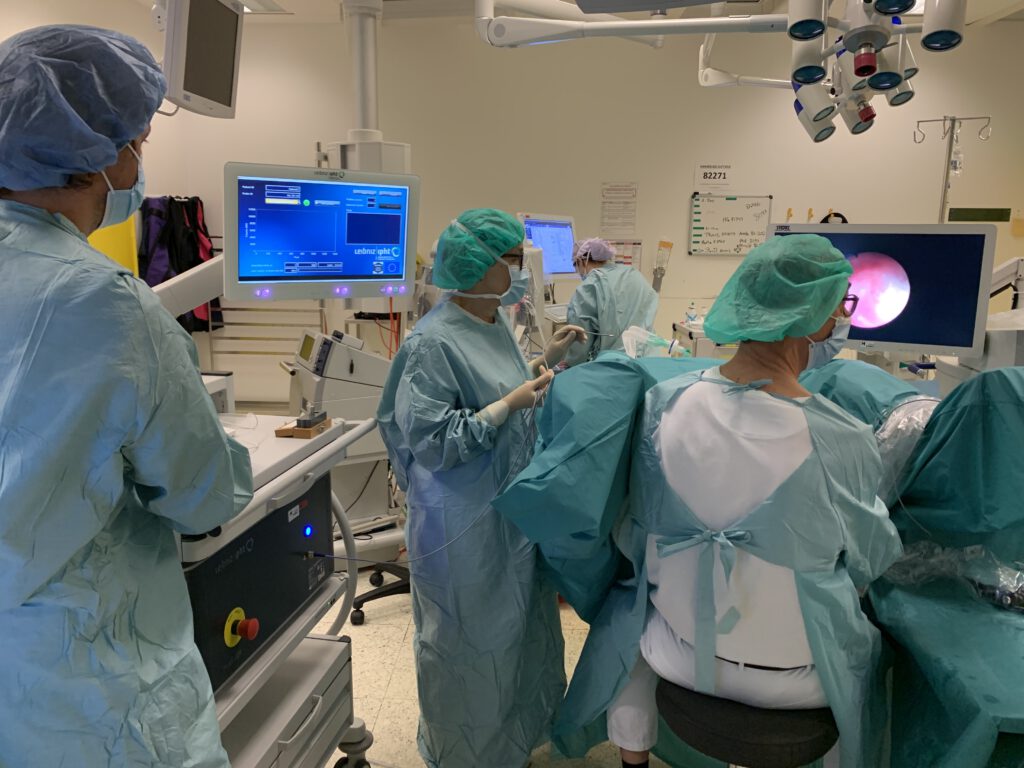
invaScope in practical testing at Copenhagen Herlev Hospital in Denmark (end of 2021): The flexible endoscopic Raman system combines all necessary components for the diagnosis of bladder cancer in a compact design.

